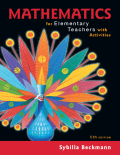
Concept explainers
* The ratio of Frank’s marbles to Huang’s marbles is 3 to 2. After Frank gives
a. Explain how to solve the problem with the aid of a strip diagram.
b. Create an easier problem for your students by changing the ratio, 3 to 2, to a different ratio and by changing the number of marbles, 30, to a different number of marbles. Make sure the problem has a sensible answer. Explain how to solve the problem.
c. Create a problem of about the same level of difficulty as the original problem by changing the ratio, 3 to 2, to a different ratio and by changing the number of marbles, 30, to a different number of marbles. Make sure the problem has a sensible answer. Explain how to solve the problem.
Want to see the full answer?
Check out a sample textbook solution
Chapter 7 Solutions
EBK MATHEMATICS FOR ELEMENTARY TEACHERS
Additional Math Textbook Solutions
University Calculus
Pathways To Math Literacy (looseleaf)
Precalculus: Mathematics for Calculus (Standalone Book)
Finite Mathematics for Business, Economics, Life Sciences and Social Sciences
Precalculus: A Unit Circle Approach (3rd Edition)
College Algebra Essentials (5th Edition)
- Number 17 pleasearrow_forwardFind area of the secarrow_forwardConsider the linear system whose augmented matrix is [1 1 1 1 1] 1 2 3 4 5 Identify which variables are basic and which variables are free, and then give the general solution of this system by expressing the basic variables in terms of the free variables. Show all of your work.arrow_forward
- -0-3-0-8 10 = = 5 Determine if w can be written as a linear combination of V1, V2, and v3. Show all of your work and justify your conclusions.arrow_forwardQ1.2 1 Point Which of the following best describes Span O a point two points a line O a plane O all of R³ Save Answer Q1.3 1 Point Which of the following best describes Span O a point two points a line O a plane O all of R³ Save Answer Q1.4 1 Point Which of the following best describes Span O a point O three points a line O a plane O all of R³ Save Answerarrow_forwardi need help pleasearrow_forward
 Intermediate AlgebraAlgebraISBN:9781285195728Author:Jerome E. Kaufmann, Karen L. SchwittersPublisher:Cengage Learning
Intermediate AlgebraAlgebraISBN:9781285195728Author:Jerome E. Kaufmann, Karen L. SchwittersPublisher:Cengage Learning Glencoe Algebra 1, Student Edition, 9780079039897...AlgebraISBN:9780079039897Author:CarterPublisher:McGraw Hill
Glencoe Algebra 1, Student Edition, 9780079039897...AlgebraISBN:9780079039897Author:CarterPublisher:McGraw Hill Algebra: Structure And Method, Book 1AlgebraISBN:9780395977224Author:Richard G. Brown, Mary P. Dolciani, Robert H. Sorgenfrey, William L. ColePublisher:McDougal Littell
Algebra: Structure And Method, Book 1AlgebraISBN:9780395977224Author:Richard G. Brown, Mary P. Dolciani, Robert H. Sorgenfrey, William L. ColePublisher:McDougal Littell Holt Mcdougal Larson Pre-algebra: Student Edition...AlgebraISBN:9780547587776Author:HOLT MCDOUGALPublisher:HOLT MCDOUGAL
Holt Mcdougal Larson Pre-algebra: Student Edition...AlgebraISBN:9780547587776Author:HOLT MCDOUGALPublisher:HOLT MCDOUGAL Elementary AlgebraAlgebraISBN:9780998625713Author:Lynn Marecek, MaryAnne Anthony-SmithPublisher:OpenStax - Rice University
Elementary AlgebraAlgebraISBN:9780998625713Author:Lynn Marecek, MaryAnne Anthony-SmithPublisher:OpenStax - Rice University





